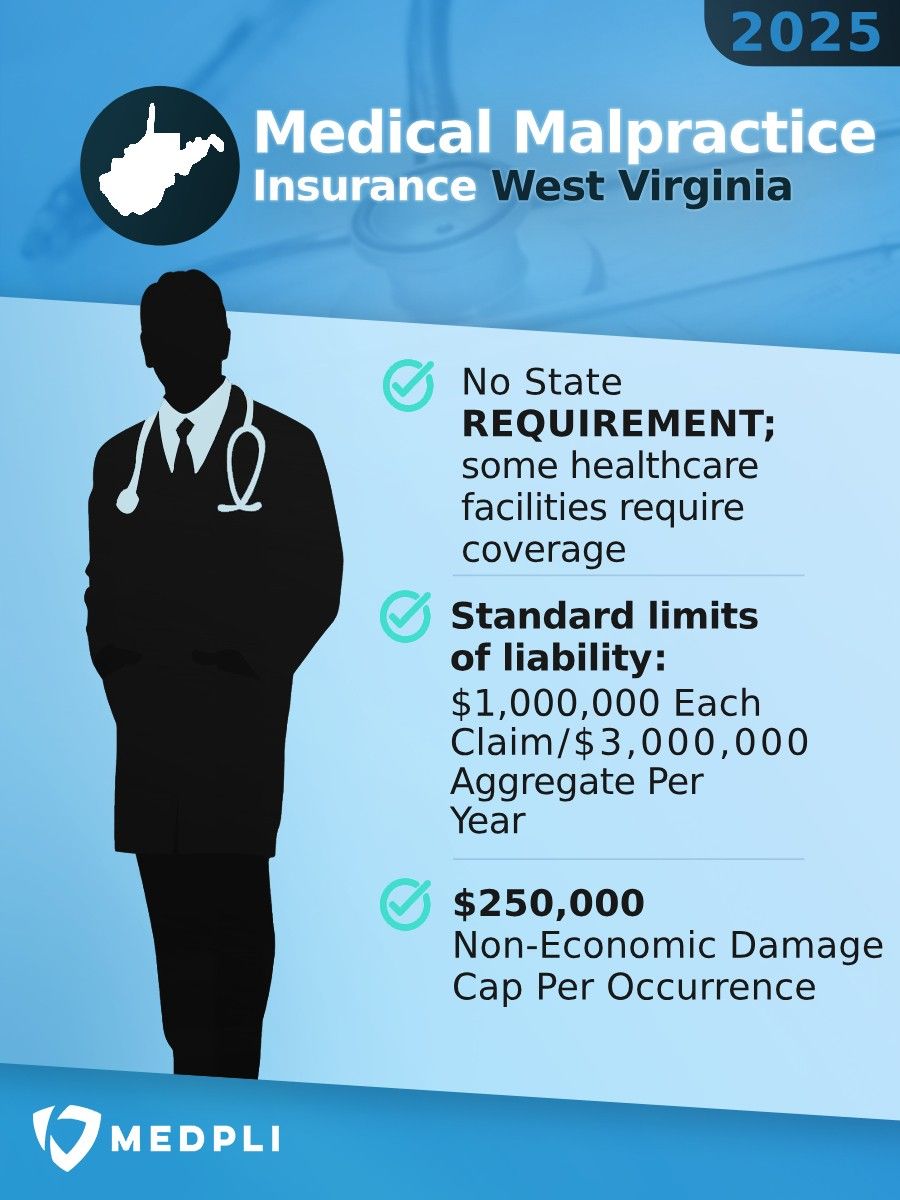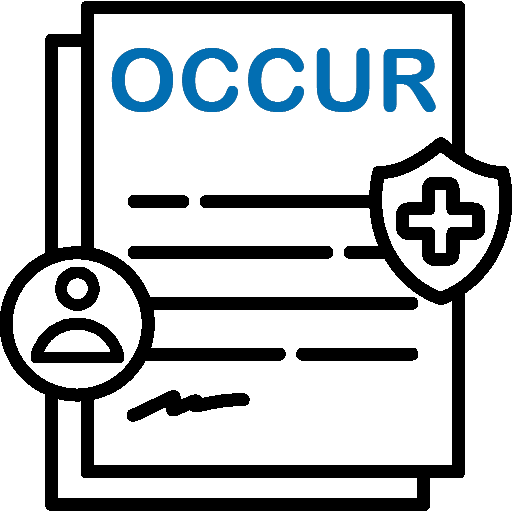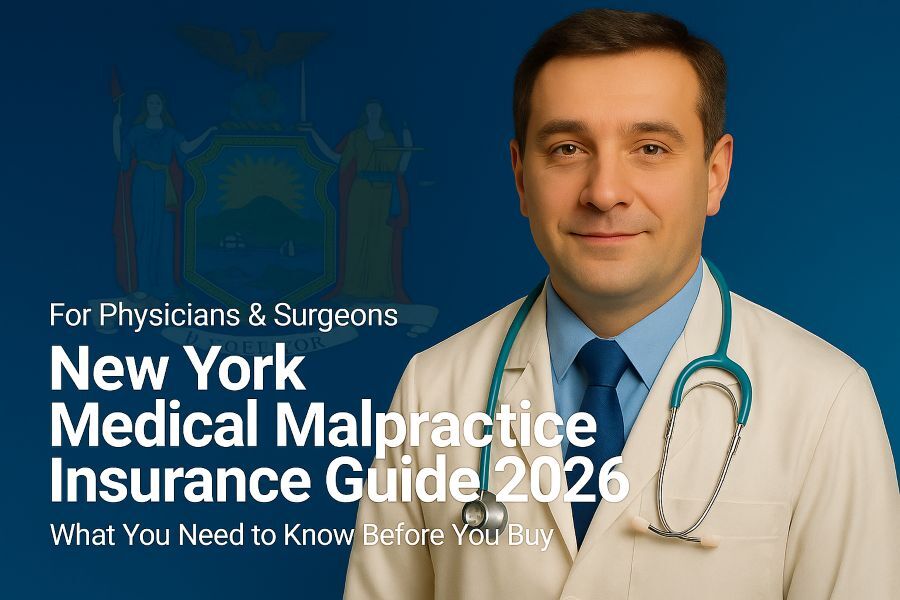Top 5 Medical Malpractice Insurance Carriers in West Virginia
We recommend carriers with an AM Best “A” or higher rating. An A-rating indicates financial strength, long-term solvency, and an established history of protecting West Virginia physicians.

2025 West Virginia Malpractice Insurance Rates by Specialty
These rate estimates are for informational purposes only and are based on the WV standard limits of $1,000,000 for each Claim / $3,000,000 Aggregate per year in coverage.
Quotes require a completed application and underwriter approval. Contact us for a custom estimate if you don’t see your specialty.
| Specialty | 2025 Annual Premium |
2025 Tail Premium |
|---|---|---|
| Anesthesiology | $32,000 | $64,000 |
| Cardiovascular Disease– Minor Surgery | $30,000 | $60,000 |
| Dermatology– No Surgery | $15,000 | $30,000 |
| Emergency Medicine | $49,000 | $98,000 |
| Family Practice– No Surgery | $20,000 | $40,000 |
| Gastroenterology– No Surgery | $26,000 | $52,000 |
| General Practice– No Surgery | $20,000 | $40,000 |
| General Surgery | $69,000 | $138,000 |
| Internal Medicine– No Surgery | $20,000 | $40,000 |
| Neurology– No Surgery | $28,000 | $56,000 |
| Obstetrics and Gynecology– Major Surgery | $94,000 | $188,000 |
| Occupational Medicine | $15,000 | $30,000 |
| Ophthalmology– No Surgery | $14,000 | $28,000 |
| Orthopedic Surgery– No Spine | $63,000 | $126,000 |
| Pathology– No Surgery | $19,000 | $38,000 |
| Pediatrics– No Surgery | $20,000 | $40,000 |
| Pulmonary Disease– No Surgery | $30,000 | $60,000 |
| Psychiatry | $15,000 | $30,000 |
| Radiology – Diagnostic | $32,000 | $64,000 |
West Virginia Medical Malpractice Payouts From 2015-2024
Rising Home Insurance Rates: The Hidden Impact on Medical Malpractice Costs
When drought, flash floods, and other severe weather strike West Virginia, the consequences go beyond physical damage—they push insurance costs higher across the state. As extreme weather grows more frequent, insurers are forced to raise rates to keep pace with rising risks. And it’s not just homeowners who are affected; businesses, including medical professionals, are feeling the pressure, too.
Why Are Insurance Rates Rising?
How the Cost of West Virginia’s Medical Malpractice Insurance Is Affected
Reinsurance providers now charge higher premiums and impose stricter payout conditions. In response, primary insurers, including those offering medical malpractice coverage in West Virginia, have increased premiums.
Severe weather isn’t just a coastal problem—it’s impacting insurance costs for everyone.
Types of Professional Liability Insurance for West Virginia Physicians
Types of Professional Liability Insurance for West Virginia Physicians
Doctors in West Virginia can choose between these two primary types of medical malpractice insurance:

- Provides coverage for incidents that occurred during the policy period IF the claim is filed while the policy is still active. If a claim is filed after the policy ends, that claim is NOT covered.
- Typically, it offers lower premiums at the start of the policy, but rates increase yearly as the policy matures.
- Physicians must obtain tail insurance coverage when a claims-made policy ends to ensure protection against future claims related to incidents that occurred during the policy period. Tail insurance premiums require a one-time cash payment equal to approximately 200% of the claims-made policy’s annual premium.

- Provides coverage for incidents that occurred during the policy period, regardless of when a claim is reported to the carrier.
- Typically, it offers more costly premiums at the start of the policy, but the rate stays constant throughout the policy’s duration.
- Physicians do not need tail coverage when an occurrence policy ends.
In 2024, West Virginia physicians were held liable for 56 medical malpractice payouts.
- Average Payout: $347,857
- Total Payout: $19,480,000
(Source: National Practitioner Data Bank)
Does West Virginia Have Damage Caps for Medical Malpractice Lawsuits?
West Virginia’s Medical Professional Liability Act limits non-economic damages to $250,000 per occurrence. However, key exceptions and additional legal requirements must be considered.
Key Rules & Exceptions
- Economic Damages: No limit
- Wrongful Death Cases: The cap increases to $500,000 for wrongful death cases or in cases of permanent, life-altering injury.
- Punitive Damages: The damage cap does not apply to punitive damages.
- Inflation: The damage caps are adjusted yearly for inflation, but are not to exceed $375,000.
- Liability Insurance Requirement: The limits on noneconomic damages do not apply if the defendant does not carry at least $1 million in medical malpractice insurance per occurrence.
- Pre-Suit Notice: At least 30 days before filing, a plaintiff must serve a notice of claim with a Screening Certificate of Merit, a written statement from a qualified medical expert outlining the physician’s credentials, the breach of standard care resulting in harm, and supporting evidence.
To learn more, read West Virginia’s full list of additional rules and exceptions.
How West Virginia’s Malpractice Laws Have Evolved
- 1970s: A nationwide medical malpractice “crisis” led to increased malpractice cases and a surge in insurance costs.
- 1986: West Virginia became the last state to enact tort reform. The damage cap was set to $1 million.
- 2003: The damage cap was lowered to $250,000 ($500,000 for wrongful death and catastrophic injury), the Screening of Merit requirement was added, and the damage cap for total civil damages was set to $500,000 for trauma centers.
- 2015: The state of West Virginia added additional Screening of Merit requirements, restricted admissibility of information in court, set inflation adjustments for damage caps, abolished joint liability, and limited admissible past medical expenses to actual expenses incurred (not just billed).
West Virginia’s recent legislation has been aimed at balancing patient & physician rights with the availability & quality of healthcare. The 2015 changes to the Medical Professional Liability Act addressed the following concerns:
- Rising costs of malpractice coverage
- “Critical proportions” of medical liabilities against trauma centers and long-term healthcare facilities
- Statewide threatened loss of physicians
West Virginia Statute of Limitations for Medical Malpractice Claims
Chapter 55, Article 7B of the West Virginia Health Care Malpractice Act states that malpractice actions must be filed within two years of the discovery of injury.
Notable Exceptions
- Nursing homes, assisted living, skilled nursing: The statute is reduced to one year if the case is brought against health care providers in these facilities.
- Fraudulent Concealment: The two-year statute is tolled in cases of deliberate fraud or collusion that prevents the plaintiff from discovering the injury.
- Minors: In the case of injury for minors, West Virginia law states that the statute must be brought within two years of the date of injury OR prior to the minor turning 12, whichever provides the more extended period to bring forth the claim.
- Statute of Repose: In no event can a lawsuit be brought to court more than ten years from the date of injury.
Why West Virginia Doctors Partner with MEDPLI
We exclusively broker medical malpractice insurance, focusing daily on making the professional liability process less burdensome and expensive for doctors.
With MEDPLI, West Virginia physicians:
MEDPLI helps doctors in every specialty.
Whether you’re a bariatric surgeon in Charleston or a dermatologist in Harpers Ferry, MEDPLI will provide you with premier coverage at a competitive rate.
Call 800-969-1339 or Request a Quote.
About the Author
Max Schloemann is a medical malpractice insurance broker helping physicians and surgeons secure Medical Professional Liability coverage. A Magna Cum Laude graduate of Southern Illinois University’s College of Business, he was named Outstanding Management Senior.
Max began his career in 2008 at an industry-leading firm and founded MEDPLI in 2017 to guide private practice doctors and physicians in transition through the complexities of malpractice insurance.
Outside of work, Max, his wife Kristen (a Physician Assistant), and their four kids enjoy the outdoors and attending the kids’ sporting events. For malpractice insurance questions, you can contact Max here.
Latest from the Medical Malpractice Insurance Blog
View our 2026 Georgia medical malpractice insurance rates by specialty, carriers, payouts & state regulations. Get your custom MEDPLI quote today.
Explore 2026 Illinois medical malpractice insurance costs, top A-rated insurers, payout trends & the latest state regulations. Get your free quote today.
GUIDE: Overview of New York medical malpractice insurance rates by specialty, top carriers, payout statistics, and state regulations. Get a custom quote here.
See 2026 California medical malpractice insurance rates by specialty, carriers, payouts, and regulations. Get your custom MEDPLI quote today.






